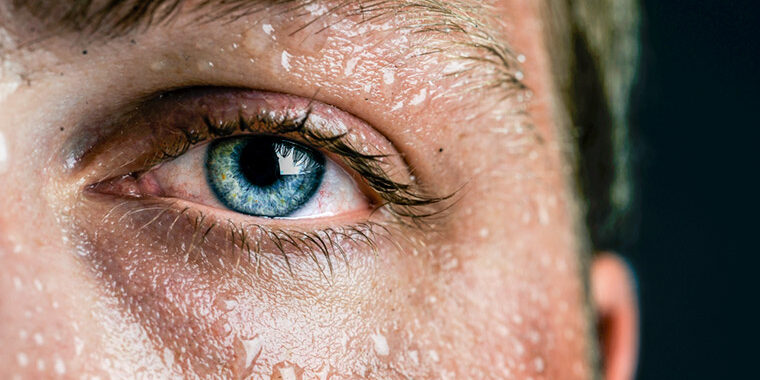Hyperhidrosis, or excessive sweating, is a common disorder that produces a lot of unhappiness. An estimated 2%-3% of Americans suffer from excessive sweating of the underarms (axillary hyperhidrosis) or of the palms and soles of the feet (palmoplantar hyperhidrosis). Underarm problems tend to start in late adolescence, while palm and sole sweating often begins earlier, around age 13 (on average). Untreated, these problems may continue throughout life.
Sweating is embarrassing, it stains clothes, ruins romance, and complicates business and social interactions. Severe cases can have serious practical consequences as well, making it hard for people who suffer from it to hold a pen, grip a car steering wheel, or shake hands.
What Causes Hyperhidrosis?
Although neurologic, endocrine, infectious, and other systemic diseases can sometimes cause hyperhidrosis, most cases occur in people who are otherwise healthy. Heat and emotions may trigger hyperhidrosis in some, but many who suffer from hyperhidrosis sweat nearly all their waking hours, regardless of their mood or the weather.
What is the Treatment for Hyperhidrosis?
Through a systematic evaluation of causes and triggers of hyperhidrosis, followed by a judicious, stepwise approach to treatment, many people with this annoying disorder can sometimes achieve good results and improved quality of life.
The approach to treating excessive sweating generally proceeds as follows:
Over-the-counter antiperspirants containing a low dose of metal salt (usually aluminum) are usually tried first because they are readily available. Antiperspirants containing aluminum chloride (for example Certain Dri) may be more effective when other antiperspirants have failed. Prescription-strength antiperspirants, which contain aluminum chloride hexahydrate.
Iontophoresis: A device which passes ionized tap water through the skin using direct electricity.
Oral medications: Anticholinergics reduce sweating.
Botox (botulinum toxin)-A: It has been approved in the U.S. by the FDA for treating excessive axillary (underarm) sweating.
miraDry: This technique uses microwave energy to permanently kill sweat glands.
Lasers: Lasers can target and kill the underarm sweat glands.
Surgery: A procedure called thoracic sympathectomy may be considered as a last resort.
Aluminum Chloride Hexahydrate and Excessive Sweating
When regular antiperspirants fail to treat excessive sweating, most doctors start by recommending aluminum chloride hexahydrate (Drysol), a prescription-strength version of aluminum chloride. It is applied just before bedtime 2 to 3 nights in a row, then roughly once a week thereafter to maintain improvement. Use as directed by your doctor. This treatment works reasonably well for many patients whose problem is excessive underarm sweating, but it is not satisfactory for most of those with palm and sole sweating.
The main side effect of Drysol is irritation, which can sometimes, but not always, be overcome by making sure the skin is dry before application and letting the medicine dry completely afterwards. Also, reducing the frequency of use or applying anti-inflammatory drugs, such as lotions containing a corticosteroid may help.
Iontophoresis for Excessive Sweating
Iontophoresis has introduced over 50 years ago as a treatment for excessive sweating. Its exact mechanism of action is still unclear, although it probably works by temporarily blocking the sweat duct. The procedure uses water to conduct an electric current to the skin a few times each week, for about 10-20 minutes per session, followed by a maintenance program of treatments at 1- to 3-week intervals, depending on the patient’s response. Iontophoresis treatments are not painful.
Patients may purchase devices for this treatment through a doctor’s prescription. Medical insurers sometimes cover the cost.
Oral Drugs for Excessive Sweating
Anticholinergic drugs such as glycopyrrolate (Robinul) are not commonly used for excessive sweating, because in order to work they often produce side effects like dry mouth, blurred vision, and urinary retention. Oral medication is typically reserved for people who have tried first-line treatments without success.
Botox and Excessive Sweating
Botulinum toxin A (Botox), a nerve toxin that can temporarily paralyze muscle, is often in the news as a cosmetic treatment for wrinkles. But it has actually been used in many areas of medicine for some time, such as in the treatment of muscle spasms and certain types of headaches. Its latest medical niche is the treatment of excessive underarm sweating.
A small amount of Botox is injected with a very fine needle into roughly 25 to 20 spots in each armpit. This may produce up to 14 months of relief from sweating. The injections are uncomfortable, but use of a very small injection needle makes them tolerable.
Now that this treatment has received FDA approval for hyperhidrosis, many health insurers are providing coverage for the injections and the Botox itself after other treatments have failed.
Currently, the FDA has not approved Botox for sweating of the palms and soles of the feet, though some physicians are administering it as an off-label use, reportedly with success. Palm injections cause more pain, requiring nerve blocks to numb the hands in order to make the injections comfortable. Skilled practitioners have used Botox for the head and face, as well.
MiraDry and Lasers
Microwave energy
miraDry is a treatment that was FDA approved in 2011 for the treatment of excessive underarm sweating. It is a noninvasive treatment using electromagnetic energy that targets heat on sweat glands, destroying them. Local anesthesia is used and the skin is cooled during this hour-long procedure. It can be repeated 2-3 times for optimal effect.
Lasers
Lasers can focus heat a narrow beam of heat to destroy underarm sweat glands and can be done faster with a faster recovery.
Surgery for Excessive Sweating
Thoracic sympathectomy is the surgical interruption of the sympathetic nerves responsible for sweating. Sympathectomy is an operation intended to destroy part of the nerve supply to the sweat glands in the skin. The surgeon inserts a special endoscopic instrument into the chest between two ribs just below the armpit. Sympathectomy is both effective and risky. Even with newer endoscopic techniques, the complications can include excessive sweating in other parts of the body and lung and nerve problems. As many of these complications are serious and not reversible, this option is rarely used, and then only as a last resort.







